How to Keep Track of Business Expenses

In other words, business expenses must be both common and accepted in your industry as well as helpful and essential in doing business. As a bonus, all of your business-related expenses are recorded on a regular basis, making it easy to track and deduct expenses where appropriate. Everything from the rent you pay each month for your office space to the paper you purchased for your printer is considered a valid business expense.
- If all this seems too much to handle, use software that makes it easy.
- That’s true as long as you’re bringing home more than $400 after your expenses are taken out.
- Tracking your spending is smart for just about anyone since it shows possible areas you can cut back on, and a mobile app makes it easier to do.
- This allows you to see your different expense types, how much each type takes up of your income and hopefully help you save money.
- In a competitive business environment, you need to be able to monitor your spending in real-time and adjust accordingly.
- Tax deductions should not be confused with tax credits, such as research and development tax credits, which are applied directly to your tax bill, not your taxable income.
You can scan receipts with your phone camera and even store them in the cloud. Also, the receipts sync with your account books, making it easy to track each transaction. Keeping tabs on business finances – including tracking specific business-related expenses – is crucial to running a business. Proper accounting improves cash flow, the oxygen your business needs to survive.
What is the best way to track expenses if I’m self-employed?
If you can spare the extra expense and don’t want to experiment with a freelancer, bookkeeping firms are a good bet. If Bench does your bookkeeping, you have the option of uploading and storing as many digital receipts and documents as you’d like in the Bench platform. Expensify integrates with a variety of other applications, such as Uber and Lyft for automatic receipt import, QuickBooks and Xero for accounting, and Zenefits and Gusto for human resources. Reviewing your business will reveal your business’s financial status and help you make relevant decisions necessary for your business growth. The Ascent is a Motley Fool service that rates and reviews essential products for your everyday money matters.
Best Business Expense Tracker Apps Of 2024 – Forbes Advisor – Forbes
Best Business Expense Tracker Apps Of 2024 – Forbes Advisor.
Posted: Sat, 23 Mar 2024 07:00:00 GMT [source]
You’ll only use this card for business purchases, so figuring out what business expenses you’ve made will be a no-brainer. For one thing, expense tracking apps usually automate expense tracking, which gives you more time to focus on your business. They also let you track mileage, which is important for tax write-offs at the end of the year, and scan or upload receipts to ensure all your expense data is in one place. Many also double as bill management apps, especially accounting software with built-in expense and billing solutions. For instance, Expensify is free for freelancers who upload only 25 expenses a month.
Best Business Software
Each time potential tax deductions hit your account, the app will ask whether the transaction belongs in personal expenses or is a business expense. Additionally, having a business bank account for business-only obligations will ensure you stay legally compliant, especially if you’re a freelancer or an owner of a small business. As a bonus, having a business credit card makes it especially easy to track business spending.

One thing to consider is that some clients can actually cost you more money than others. Every month, your manager reports that the same three clients call to say they are dissatisfied with the job and won’t pay unless they get a significant discount next time. Or perhaps an out-of-state keep track of business expenses client requires too much face-to-face time, resulting in extra travel every time that client books a job. A P.O., or Purchase Order, is not necessarily required for every transaction, but when it is, it is generated by the client when he/she first requests your product or service.

